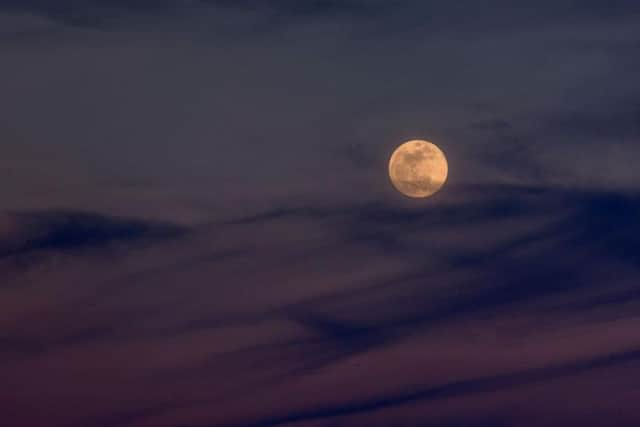Penumbral lunar eclipse 2020: when the eclipse is in January, and how to see it from Scotland
Following on from the peak of the Quadrantids meteor shower a few days ago, stargazers have a penumbral lunar eclipse to look forward to.
But what exactly is a penumbral lunar eclipse, and how does one see it? And why is January's full moon called a 'Wolf' Moon?
Here's everything you need to know.


What is a penumbral lunar eclipse?
Advertisement
Hide AdAdvertisement
Hide AdDuring a penumbral lunar eclipse, the moon passes through the edges of the 'shadow' that our planet casts into space, in which a portion - but not all - of the Sun's light is obscured.
Unlike total lunar eclipses during which the moon passes entirely through the Earth's shadow, the surface of the moon does not appear to turn a reddish tint as seen from Earth.
Instead, the penumbra causes only a subtle dimming of the lunar surface.
When is the eclipse?
The eclipse takes place on the evening of Friday 10 January.
The eclipse will be at its greatest point at 7.10pm, so that's when you'll want to turn your attention to the skies.
But fear not, if you're otherwise engaged at that exact time, the eclipse technically takes place over a four-hour period, from around 5.08pm to roughly 9.12pm, although the effects of it will be noticeably less pronounced.
What will it look like?
That's not to say the eclipse will be particularly noticeable at any point throughout the evening.
Don't go looking to the heavens with expectations that are too high; there will be no red glow like you might see with a total lunar eclipse.
Advertisement
Hide AdAdvertisement
Hide AdDuring a penumbral eclipse, the moon simply dims as it passes through the Earth's penumbral shadow.
What is a 'Wolf' Moon?
The majority of pre-modern calendars used the moon as the basis for the names of their months, a convention ended by the introduction of the solar Julian and Gregorian calendars.
In modern times, the moons have developed new names, the majority of which are attributed to Native Americans. They tend to hold particular resonance with the time of year when they fall.
For example, January’s “Wolf Moon” was named by both Europeans and Native Americans because of the lupine howling which haunted the midwinter.
How do I see it?
All you need to see the penumbral eclipse are clear night skies.
Those can often be hard to come by in the UK - especially in these winter months - and the Met Office's current forecast paints the picture as "changeable with showers or longer spells of rain."
There will also be some "drier and brighter/clear spells", and "it will turn drier and brighter for a time" starting around 10 January.
When is the next penumbral eclipse?
Penumbral eclipses aren't particularly rare, and there are three more to come in 2020.
Advertisement
Hide AdAdvertisement
Hide AdThe first falls on 5 June, and will only be visible briefly in the UK at moonrise, and the second comes a month later on 5 July, and will only be visible from the UK at moonset.
The final penumbral eclipse of 2020 falls on 20 November, and will be visible from most of the UK at moonset.
What about the next total lunar eclipse?
Total lunar eclipses are surprisingly common, but that being said, we're now in the midst of a lull period in their frequency. The next one won't be until 26 May 2021 - over a year away.
Even then, those in the UK won't be able to view it as the eclipse will take place on the other side of the globe: New Zealand and eastern Australia will get the best view.
The next total eclipse visible from the UK won't be for another ten years, when Britain is perfectly positioned to witness one on the night of 20 December 2029.